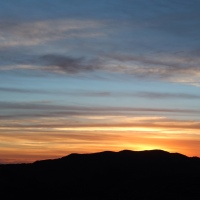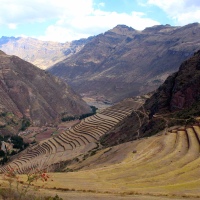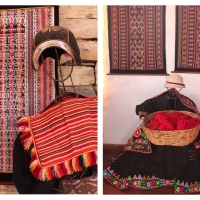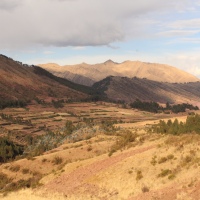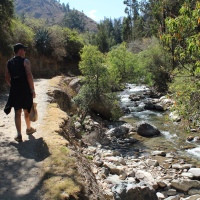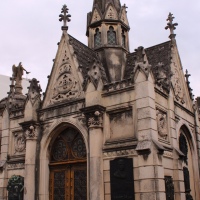Having had our fill of the altiplano it was time to get a taste of the epic Amazon Basin. Most often associated with Brazil, the Basin actually covers more than half of Bolivia. Surprisingly, this part of Bolivia is not very popular with tourists, who tend to limit themselves to a short visit, if they go at all.
There are two main entry points to the Basin: Rurrenabaque and Trinidad. We opted for Rurrenabaque as it was closest to La Paz. Our plan was to use Rurrenabaque as a launching point for a trip to the jungle and the pampas (grass wetlands). We then planned to fly to Trinidad, from where we would travel to San Ignacio de Moxos and see what Lonely Planet has claimed is the best cultural festival in the Amazon.
The Jungle of Madidi National Park
The flight from La Paz to Rurrenabaque is beautiful, passing over snow capped mountains, winding rivers and endless jungle. Getting out of the tiny plane in the palm tree-lined airport and being instantly confronted with the humidity and heat was a shock to the system after the freezing cold altiplano, but it also felt like paradise.
We wanted to do a jungle tour and after looking into our options, decided to go with Chalalán Ecolodge. A key selling point was that Chalalán is five hours up river and consequently goes deeper into the jungle of Madidi National Park than other tours. Also, Chalalán is rated by National Geographic as one of the top fifty ecolodges in the world (and its the most affordable of the pick), so we thought that sounded like a great opportunity to do something special.
We spent the night in Rurrenabaque enjoying local fresh fish and caipirinhas (its good to be so close to Brazil!). Our guide Rico picked us up early the next morning, along with our trekking companions Madeleine, Ruth and Simon, and we set off in our little banana boat.

The jungle exhales after a night of rain.
The lodge is accessed from the Rio Tuichi, which branches off the larger Rio Beni. The boat trip is stunning. We were able to see capybaras, monkeys, caiman, turtles, as well as many different types of water birds and birds of prey (there is a list at the end for those that love lists!). We had seen many of these animals and birds before while we were in the Pantanal, but it was wonderful to see them again in a different environment. Check out our posts on the Pantanal to see the photos.

Arriving at Chalalan.
We arrived at Chalalán around lunch time and were met by a group of happy guys from the local community who thankfully helped us carry our bags the 2km walk to the lodge.
Within minutes of getting out of the boat we were surrounded by colourful butterflies, a snake (which turned out to be a Ferdiland snake, the second most venemous snake in the area!), beetles, tree-cutter ants, birds and the distant sound of howler monkeys. There was a definate sense of sharing space with nature, and the constant noise of the jungle reminds you that there is so much life around you. It was quite amazing!

Cow Bird; Butterfly; Tree Cutter Ants.
Chalalán is set on a lagoon amongst beautiful rainforest. The Ecolodge was established by the local indigenous community of San José de Uchupiamonas. The community decided to set up the lodge in the early 1990s as a way to earn money, provide jobs and development for their community whilst also protecting and preserving their land and culture. They worked with many people to secure funding, including an Israeli man who helped write a proposal and get funding from Conservation International and the Interamerican Development Bank. With this money, they were able to build lodges in their traditional style, train members of the community in business and hospitality, and market the ecolodge to tourists. The community is now fully responsible for running the business of Chalalán Ecolodge and through this has ensured that their culture and environment will live on for future generations.

Sleeping huts and canoes by the lagoon at Chalalán Ecolodge.

Chalalán Lagoon. We went out on the lagoon every afternoon.
We spent four days/three nights at Chalalán occupying our day looking for animals by walking through the jungle or rowing around the lagoon. The day was broken up into a morning walk, an afternoon siesta, a twilight walk and paddle and a night walk. Basically we were given plenty of opportunities to see the flora and fauna.
A Meeting with Monkeys
It was on the afternoon of our first day that we had our first close encounter with monkeys. We were paddling out on the lagoon when Rico guided us to a spot that the monkeys like to visit at twilight. We watched with joy as yellow squirrel monkeys popped out of the thick vegetation. They were followed by kapuchin monkeys, affectionally known as cappuccino monkeys because of their brown colouring.
They came right down to the water, precariously hanging off drooping branches before spinning around and scampering back up the tree. It was great fun and provided us with good photo opportunities.
Things almost came to a bad end though – Mark spotted a caiman gliding in under a low hanging branch. Two yellow squirrel monkeys were less than a metre from the water's surface, oblivious to the arrival of a predator. We waited with baited breath but, possibly because of our presence, the caiman did not make a move. A National Geographic moment was averted!

Brown Kapuchin Monkeys and Yellow Squirrel Monkeys.
More Monkey Madness
On the second day we went on a five hour loop walk to try and find spider monkeys. The jungle was quiet though and apart from the startled bolt of a tapir, the morning was fairly uneventful. Eventually we reached a small cliff and began following it to the right. Soon we heard the unmistakable sound of a holwer monkey giving voice to his throaty growl.
We flipped into stealth mode and began creeping in the direction of the howl. We crossed into a thicket and all of a sudden sound exploded all around us! The trees above us were shaking with the movement of several packs of monkeys, moving together in a raucous wave.
We recognised the distinct high pitched squeek of the yellow squirrel monkey, accompanied by kapuchin monkeys. Then Rico yelled out to us – he had spotted a spider monkey! Now we were running through the jungle trying to keep up with spider monkeys, who with their long arms and tails were quickly swinging through the canopy. Surprisingly no-one ran into a tree.
It was an exhilerating experience. Four different species of monkey all in one spot! Magic. The howler monkeys had gone quiet but our guide managed to spot them in a tall tree. A couple of them came down to the lower branches to get a good look at us and we found ourselves at the receiving end of a sightseeing experience.

Wandering through the rainforest looking for animals.
Stalking White Lipped Peccarys
On the third day we were making our way around the northern side of the lagoon when we heard the grunts of wild pigs, or peccarys. Rico signalled for us to crouch down behind trees and we went into our best stealth mode. These pigs have been known to surround people and kill them, and had done so to one of the local members of the community not that long ago. Even jaguars are wary – they have learnt to pick off strays at the back of the pack to avoid getting mauled. We looked around for trees to climb, but were not that convinced we would get up any quickly enough if we were surrounded by angry pigs!
Rico had cleverly predicted that they would come up the slope and cross our path. We waited and waited as the sound of twigs snapping and pigs grunting became louder. There seemed to be a lot of them…
It was really exciting when they finally appeared. At first they didn't notice us, but a male eventually did and we found ourselves being stared down! Time literally stopped. He was so close we could almost count the white hairs on his snout. Fortunately he decided we weren't a threat and we watched in amazement as around 100 peccarys passed in front of us. There were so many, from huge males to tiny babies running after their mothers. It was impossible to get a good photo in poor lighting while crouching under a tree hiding from a herd of pigs, but we tried!

Walking through the jungle; herds of peccary rushing past; Mark in the rainforest; mushrooms.
We spent plenty of time searching for animals, which we could sometimes hear but not see. We found a hole in a tree where an ocelot sleeps and saw lots of holes in the ground that had been abandoned by armadillos. We heard tapirs from a distance, saw jaguar and puma tracks a short walk from the lodge, but we were unable to actually catch a glimpse. It rained quite a lot while we were there, which made it difficult to see the animals because they too wanted to get out of the cold weather.

Jaguar footprints.
Creepy Crawlies
Many of the animals in the jungle only come out at night so we ventured out after dark to see what we could find. Mark was struck by a bout of Australasian stupidity and went out only wearing thongs (aka jandals or flip flops). This quickly proved a bad idea when we came across a coral snake within five minutes. In fact it was an eventful night: we saw an amazon tree boa in Madeleine's roof and along the track Rico introduced us to a giant black tarantula (as big as a man's hand). We also saw a golden orb spider, false scorpion spider, spitting spider (20cm range), tiger spider, plus lots of other creepy crawlies. Ironically, Madeleine and Saskia were bitten by hundreds of tiny ants despite the fact that they were wearing shoes and socks and Mark didn't get bitten at all!

Golden Orb Spider.

Snakes and spiders everywhere! Clockwise from top left: Tiger Spider, Amazon Tree Boa, Black Tarantula, Tiger Spider, False Scorpion Spider and Coral Snake.
Green Things
The plant life was abundant and dominated the landscape. Some of the trees are really unusual. The walking tree, for example, can shift its location to better catch sunlight. It does this by growing new roots, similar to a mangrove tree, which it slowly shifts its weight onto (see the photo below). The strangler fig is a parasitic plant that slowly grows around a host, then seals it off from light. The host then rots away inside. Brutal.
The lodge itself is made out of local mahogany, which remain in the park thanks to the vigilance of the locals, and we saw huge 200 year old cedar trees. Rico also pointed out the medicinal uses of various plants and fungi and warned us about which ones not to touch.

The roots of this tree spread up to ten metres along the ground.
The tree roots are actually very shallow because there are no nutrients deep in the soil. As a result we were constantly stepping over roots. One species of tree had red roots, creating the impression of being the veins of the jungle.

Vines and orchards live on other trees, some of which are incredibly old.
In addition to the many walking tracks around the lodge, we also had the opportunity to use the canoes on the lagoon. This provided a quiet way to approach monkeys in the trees and to see birds flying over the top of the canopy. We also went swimming from the pier to the amusement of most other guests who were too scared to go jumping in the water when there were caiman close by. We weren't scared…those caiman have got nothing on crocs in Australia!

Top: Mark paddling the canoe with Rico and Madeleine; Bottom: Simon and Ruth look for monkeys in the trees from their canoe.
All that would have been great but the staff arranged a cultural night for us. We had a traditional dinner, with fish cooked in coconut milk and wrapped in banana leaves (also a common way of cooking fish in the Pacific). We learnt about community traditions and how to make an offering to mother earth, or pachamama. This involed taking a shot of 'puma milk', a combination of singani, milk, cinnamon bark, sugar and hot water. Suffice to say it is one drink the world could do without. We spent the rest of the night dancing with the staff to traditional music, which was lots of fun!

Traditional music; coca leaves and baby puma milk; fish in coconut milk wrapped in banana leaves.
Overall, our experience at Chalalán was wonderful and we highly recommended a visit if you ever have the opportunity!
The Lists
So as promised we have included a list of the wildlife we saw, many of which are not mentioned above. Might be helpful for peeps weighing up whether to make the trip.
Monkeys
Note that about 12 species of monkey are endemic to the Park.
- Howler monkey
- Kapuchin monkey
- Night monkey
- Spider monkey
- Yellow squirrel monkey
Spiders
- Black tarantula
- Brown/banana spider
- False scorpion spider
- Golden orb spider
- Golden silk spider
- Spitting spider
- Tiger spider
Snakes
- Amazon tree boa
- Common musarana snake
- Coral snake
- Ferdiland snake
Birds
According to Wikipedia the Park has over 1,000 bird species, representing 11% of the world’s 9,000 bird species.
- Amazon kingfisher
- Blue heron
- Cap heron
- White necked heron
- Rufescent tiger heron
- Grey egret
- Snowy egret
- Chestnut fronted macaw
- Red and green macaw
- Blue and yellow macaw
- Blue headed parrot
- Black winged vulture
- King vulture
- Whitewing swallow
- Crimson crested woodpecker
- Russelback arapendula
- Chachalaca
- Hoatzin (cow bird)
- Blue throated pipe pidgeon/guan
- Cormorants
- Tucans (not sure which types)
- One badass harpy eagle
The rest
- Red deer
- White lipped peccary
- Caiman
- Capybara
- Turtles
- Amazon tree frog
- Many butterflies, moths, beetles and a centipede






































































































